Click on images to enlarge
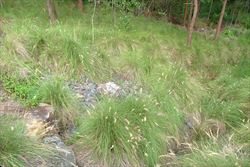
infestation (Photo: Sheldon Navie)

habit (Photo: Sheldon Navie)

habit (Photo: Sheldon Navie)
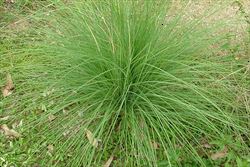
leaves (Photo: Sheldon Navie)

close-up of young seed-head with feathery styles (Photo: Sheldon Navie)
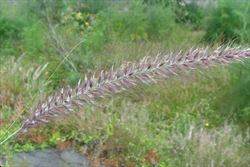
purplish-coloured seed-head (Photo: Sheldon Navie)

flower spikelets (Photo: Sheldon Navie)
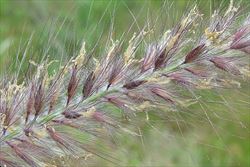
close-up of flower spikelets with numerous bristles (Photo: Sheldon Navie)
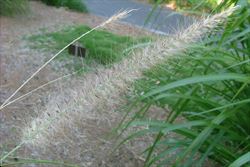
mature seed-head (Photo: Sheldon Navie)
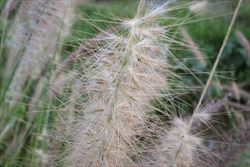
close-up of mature flower spikelets (Photo: Sheldon Navie)

comparison of swamp foxtail (Pennisetum alopecuroides), with broader leaves and stiff upright seed-heads in the foreground, and fountain grass (Pennisetum setaceum), with narrower leaves and drooping seed-heads in the background (Photo: Sheldon Navie)
Scientific Name
Cenchrus setaceus (Forssk.) Morrone
Synonyms
Pennisetum setaceum (Forssk.) Chiov.
Phalaris setacea Forssk.
Family
Gramineae (South Australia)Poaceae (Queensland, New South Wales, the ACT, Victoria, Tasmania, Western Australia and the Northern Territory)
Common Names
African fountain grass, crimson fountain grass, crimson fountaingrass, fountain grass, fountaingrass, green fountain grass, plume grass, purple fountain grass, red fountain grass, tender fountain grass
Origin
Native to northern and eastern Africa (i.e. Algeria, Egypt, Libya, Morocco, Tunisia, Eritrea, Ethiopia, Somalia, Sudan, Kenya, Tanzania, Zambia and Zimbabwe) and south-western Asia (i.e. Oman, Saudi Arabia, Yemen, Lebanon and Syria).
Naturalised Distribution
Widely distributed, with a scattered presence throughout most of Australia. It is most common near inhabited coastal areas in south-eastern Queensland, central New South Wales, south-eastern South Australia and south-western Western Australia. Present in other parts of these states and also recorded from Victoria and the Northern Territory.
Naturalised overseas in southern Africa, New Zealand, southern USA (i.e. California, Oregon, Arizona, New Mexico, Colorado, Tennessee, Louisiana and Florida) and on some Pacific islands (e.g. Fiji, New Caledonia, Hawaii).
Habitat
A weed of roadsides, railways, waste areas, disturbed sites, open woodlands, grasslands, waterways, coastal environs, pastures, and rocky habitats in tropical, sub-tropical and warmer temperate regions.
Habit
A densely-tufted, long-lived (i.e. perennial) grass with drooping leaves and stems usually growing 20-100 cm tall, but occasionally reaching up to 1.5 m in height.
Distinguishing Features
- an upright tufted grass with very narrow leaves and flowering stems growing up to 1 m or more tall.
- its long spike-like seed-heads (6-30 cm long) are reddish, pinkish or purplish in colour.
- these seed-heads contain large numbers of densely packed stalkless flower spikelet clusters.
- each flower spikelet cluster is surrounded by numerous feathery bristles (12-26 mm long) and one significantly larger bristle (16-40 mm long).
- its mature seed-heads turn straw-coloured or whitish and the seeds are shed with the feathery bristles still surrounding them.
Stems and Leaves
The flowering stems (i.e. culms) are upright (i.e. erect or slightly drooping) and either unbranched or sparsely branched. These stems arise from the base of the plant (i.e. the crown) along with the majority of the leaves.
The leaf blades are linear in shape, very narrow (15-40 cm long and 1-3 mm wide), and somewhat rough to the touch (i.e. scabrous). They are mostly hairless (i.e. glabrous), but occasionally have a few hairs towards the base. Where the leaf sheath meets the leaf blade there is a small fringe of hairs (i.e. ciliate ligule).
Flowers and Fruit
The long and spike-like (i.e. spiciform) seed-head is actually a spike-like panicle with very short branches. These seed-heads are upright (i.e. erect) or drooping in appearance (6-30 cm long). They are quite feathery or bristly in appearance and borne at the top of the flowering stems (i.e. culms). Younger seed-heads are reddish, pinkish or purplish in colour and consist of large numbers of densely packed, stalkless (i.e. sessile) flower spikelet clusters. Each of the flower spikelet clusters contains 1-3 spikelets and is surrounded by numerous long feathery (i.e. plumose) bristles (12-26 mm long). However, one of these bristles is significantly longer than the others (16-40 mm long). The elongated (i.e. lanceolate) fertile flower spikelets (4.5-6.5 mm long) consist of a lower sterile floret and an upper fertile floret. Flowering occurs sporadically throughout the year, but mostly during summer.
The mature seed-heads turn straw-coloured or whitish and the flower spikelets are shed from the seed-head intact, along with the surrounding bristles (i.e. involucre). The seeds themselves (i.e. the grains) are yellowish-brown in colour and smooth in texture.
Reproduction and Dispersal
This species reproduces by seed. These light and feathery 'seeds' are primarily dispersed by wind movement. They may also become attached to clothing, float on water, or be spread in dumped garden waste.
Environmental Impact
Fountain grass (Cenchrus setaceus) is regarded as an environmental weed in Queensland, the Northern Territory, Western Australia, New South Wales and South Australia, and as a potential environmental weed in elsewhere in Australia. It was also recently listed as a priority environmental weed in at least one Natural Resource Management region, and appears in the Global Invasive Species Database.
Legislation
This species is declared under legislation in the following states and territories:
- New South Wales: Class 5 - a restricted weed which must not be sold, bought or knowingly distributed (throughout the entire state).
- Queensland: Class 3 - this species is primarily an environmental weed and a pest control notice may be issued for land that is, or is adjacent to, an environmentally significant area (throughout the entire state). It is also illegal to sell a declared plant or its seed in this state.
- Western Australia: Unassessed - this species is declared in other states or territories and is prohibited until assessed via a weed risk assessment (throughout the entire state).
Management
For information on the management of this species see the following resources:
- the New South Wales Department of Primary Industries Weed Alert on this species, which is available online at http://www.dpi.nsw.gov.au.
Similar Species
Fountain grass (Cenchrus setaceus) is very similar to African feather grass (Cenchrus macrourus), mission grass (Cenchrus polystachios), Deenanth grass (Cenchrus pedicellatus) and swamp foxtail (Cenchrus purpurascens) and relatively similar to elephant grass (Cenchrus purpureus) and feathertop (Cenchrus longisetus). These species can be distinguished by the following differences:
- fountain grass (Cenchrus setaceus) is a moderately-sized long-lived (i.e. perennial) grass (50-150
cm tall) with relatively elongated, reddish or pinkish-coloured seed-heads.
The main stem (i.e. rachis) of the seed-head is angular and the long bristles
(up to 25 mm or more) are hairy (i.e. plumose).
- African feather grass (Cenchrus macrourus) is a large long-lived (i.e.
perennial) grass (usually 1-2 m tall) with very elongated, greenish or
yellowish-coloured seed-heads. The main stem (i.e. rachis) of the seed-head is
rounded and the relatively short bristles (mostly less than 10 mm long) are
rough (i.e. scabrous).
- mission grass (Cenchrus polystachios) is a large long-lived (i.e. perennial) grass (usually 2-3 m
tall) with very elongated, yellowish or brownish-coloured seed-heads. The main
stem (i.e. rachis) of the seed-head is angular and the relatively long
bristles (4-25 mm long) are hairy (i.e. plumose).
- Deenanth grass (Cenchrus pedicellatus) is a moderately-sized short-lived (i.e. annual or
perennial) grass (usually 30-150 cm tall) with elongated, pale
purplish-coloured seed-heads. The main stem (i.e. rachis) of the seed-head is
angular and the relatively long bristles (6-24 mm long) are hairy (i.e.
plumose).
- swamp foxtail (Cenchrus purpurascens) is a moderately-sized long-lived (i.e. perennial) grass
(usually 60-100 cm tall) with relatively elongated, purplish-coloured
seed-heads. The main stem (i.e. rachis) of the seed-head is rounded and the
relatively long bristles (15-30 mm long) are hairless (i.e. glabrous).
- elephant grass (Cenchrus purpureus) is a very large and robust long-lived (i.e. perennial) grass
(1-7 m tall) with elongated, greenish or purplish-coloured seed-heads. The
main stem (i.e. rachis) of the seed-head is rounded and the relatively long
bristles (10-16 mm or more long) are rough or hairy (i.e. scabrous to
plumose).
- feathertop (Cenchrus longisetus) is a relatively small long-lived (i.e. perennial) grass (15-100 cm tall) with relatively broad, oblong-shaped, whitish-coloured seed-heads. The main stem (i.e. rachis) of the seed-head is angular and the very long bristles (30-70 mm long) are hairy (i.e. plumose).

